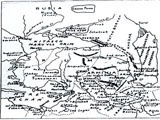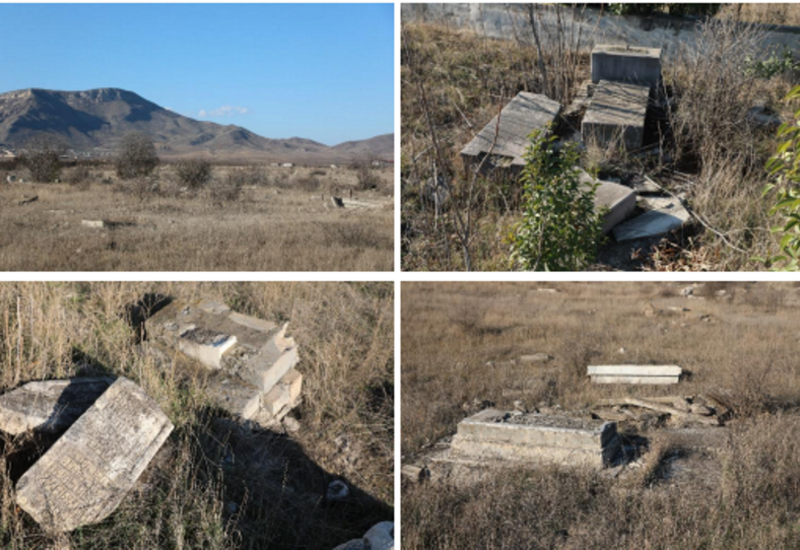|
|
TODAY.AZ / Society
Russian-published "Encyclopedia for Children" shows Azerbaijani, Turkish, Iranian and Georgian territories as Armenian
25 April 2008 [16:11] - TODAY.AZ
Armenian map in Middle Ages in South Caucasus was reflected in the "Encyclopedia for Children" published in Russian "Avanta+" publishing house, APA reports.
 Azerbaijani, Turkish, Georgian and Iranian lands were shown as territories of Armenia in Geography volume of Encyclopedia published in 2007 (editorial staff: M. Aksyonova, A. Eliovic etc.) Moreover, there are many distortion and mistakes in the article. Jabi Bahramov, Deputy Director of Institute of History in ANAS told APA that there was not any Armenian territory in middle centuries.
Azerbaijani, Turkish, Georgian and Iranian lands were shown as territories of Armenia in Geography volume of Encyclopedia published in 2007 (editorial staff: M. Aksyonova, A. Eliovic etc.) Moreover, there are many distortion and mistakes in the article. Jabi Bahramov, Deputy Director of Institute of History in ANAS told APA that there was not any Armenian territory in middle centuries."Local people of South Caucasus remained beyond and article on Geography in Armenia in middle century was included in Geographical part. There were Byzantine, Arabian invasion, Mongolian and Saljug periods in middle centuries, but there was not any Armenian state in the history till 1918. There was not shown Armenian country in South Caucasus in any historical sources. XV-XVIII centuries are the period of Safavi Empire of Azerbaijan. We come across the name of Armenia in the territory of Turkey’s Van Lake. Armenians were brought to South Caucasus during the period of tsar Russia systematically in 1804-1813, 1826-1828”, he said.
The historian also stated that it was wrong to say science and literature were flourishing in Armenia, while in all counties science and culture were perishing.
"Any nation, ethnic group should have its state, economic, stable socio-political situation so that its culture can flourish. How can science and enlightenment improve in the unknown area called Armenia, which lacks all this? According to the article, father of Armenian history Movses Khorenatsi said that beginning from the fifth century these territories belonged to Armenian state. French philosopher Auguste Cahier in his book "Extracts from ancient history" written in 1805 called “father of Armenian history" the greatest swindler among historians. It is not even known when he lived. Some sources say he lived in the 6th and others say he lived in the 7-8th centuries," he said.
The names of Anania Shirakatsi, Claudius Ptolomeus are mentioned in the article. The source of the map is not shown. Azerbaijani scientist said there was no state called Armenia in Ptolomeus’ map.
"It is uncertain in what language the map is. This is Latin script, but language is not clear. Russia is shown as the neighbor of Armenia in the map. The word "Russia" appeared in the 18th century. This name was given to Rus state in the reign of Peter I. How can the name of Russia fall under medieval Armenian map, while before it had been called Kievan Rus, Moscow? How could the word "Russia" be written in Armenian map, while Russian state is not written in the historical literature of Russia by the 18th century? It is also written Persian Empire in the map. This expression has been known as "Parsia" since the 9th century B.C. and means far. This phrase has been used in Western and Russian history since the Middle Ages (16th century). Persians had not been in power after the occupation of Arabians until 1924. Only in 1924 Persians mounted a coup and seized the power," he said.
The next false information in the article is about the great geographical discoveries in the Atlantic and Indian oceans. It turns out that Armenians had a great dockyard, ships and they discovered that period. Bahramov said that publication of such books in Russia was not accidental and Armenians used all opportunities of Russia in anti-propaganda towards Azerbaijan.
"282 such false books published in the US and Europe were found when Armenians raised genocide claims against Turkey in 1919. Armenians have already published over 4 million books to falsify Azerbaijan’s history and translated into many languages. The only way to fight against them is to publish books of Azerbaijani scientists and release in different countries through embassies and Diaspora," he said.
/APA/
URL: http://www.today.az/news/society/44549.html
 Print version
Print version
Views: 2409
Connect with us. Get latest news and updates.
See Also
- 08 February 2025 [10:30]
Temporary restrictions on meetings in military units - 07 February 2025 [14:55]
Remains of martyr from First Garabakh War laid to rest after 31 year - 07 February 2025 [13:04]
Azerbaijan sends new batch of humanitarian aid to Ukraine for power restoration - 07 February 2025 [11:22]
Regular bus service launches between Mingachevir, Khocaly, Khankendi, and Shusha - 06 February 2025 [14:13]
T?B?B: Four people injured in Aktau plane crash continue to be treated in hospital - 04 February 2025 [15:00]
Azerbaijan prevents narcotics smuggling at Goytepe border - 04 February 2025 [13:38]
Azerbaijan to take legal measures over Russian inscription on ‘Russian House’ in Baku - 04 February 2025 [12:03]
Khojaly welcomes first baby in Ballija Village - 03 February 2025 [15:17]
Large-scale construction projects underway in liberated Agdam - 03 February 2025 [14:18]
All flights from Baku to Astrakhan suspended
Most Popular
 Kazakhstan's report confirmed Baku's correctness. What will Moscow say now?
Kazakhstan's report confirmed Baku's correctness. What will Moscow say now?
 Destroyed cemeteries in Karabakh: Armenians have raised a question that incriminates them
Destroyed cemeteries in Karabakh: Armenians have raised a question that incriminates them
 Azerbaijan advances solar power plant construction with UAE’s Masdar and SOCAR Green
Azerbaijan advances solar power plant construction with UAE’s Masdar and SOCAR Green
 OTS and Turkish Investment Fund discuss boosting economic cooperation
OTS and Turkish Investment Fund discuss boosting economic cooperation
 Russian propagandists work hard on lies about the AZAL disaster
Russian propagandists work hard on lies about the AZAL disaster
 Preliminary report released on AZAL Embraer 190 crash near Aktau airport
Preliminary report released on AZAL Embraer 190 crash near Aktau airport
 Armenian PM agrees not to deploy EU troops on border with Azerbaijan
Armenian PM agrees not to deploy EU troops on border with Azerbaijan
